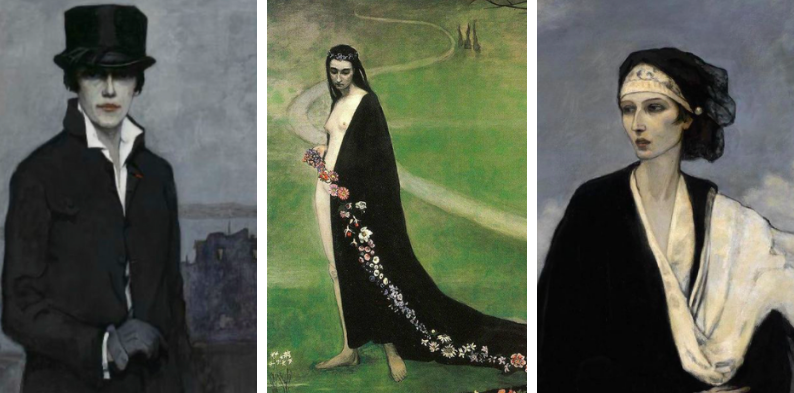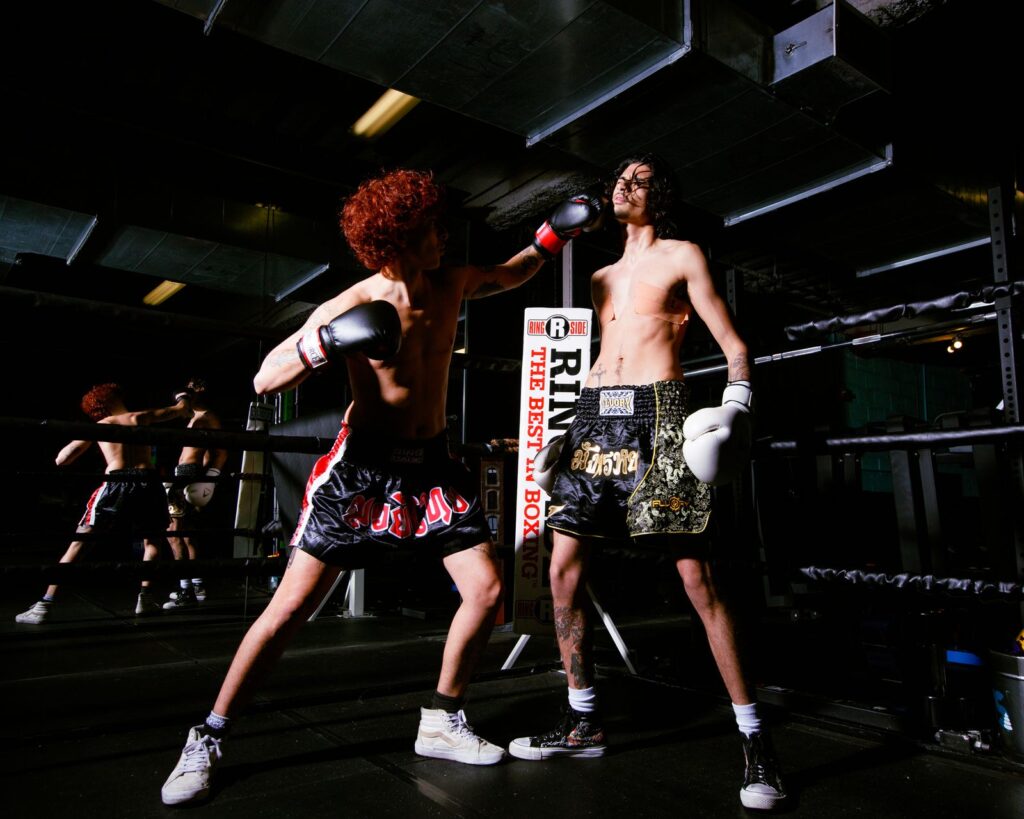A Lesbian, Bohemian, & Parisian Legend: Romaine Brooks’ Art Forever Echoes Her Defiant Spirit

When I look at her self-portrait, I connect with the bohemian Paris of her day, to the lesbian artist who lived and loved. I am reminded that my present is what it is because of those who came before, and that I too am a small link to our queer, and hopefully freer, future.
Romaine Brooks (1874-1970) was born in Rome, Italy as Beatrice Romaine Goddard to an affluent American family on her mother’s side. After her parents divorced, her early miserable years were spent in New York, abandoned to a foster situation and boarding schools. At age 17, her wealthy grandfather sent her to a finishing school in Switzerland where she excelled in art. Two years later, Brooks began studying at a prominent art academy in Rome. In 1900 at age 26, she relocated to Paris, determined to be a painter and connect with a vibrant cultural scene that was accepting of homosexuals and artistic mavericks.
On the Left Bank in Paris, queer artists and the brightest bohemian minds could create and live their truth, protected from homophobic laws, police, and condemnation in their countries of origin. Painters from many lands flocked there, and Paris became the capital of modern art, with the likes of Picasso, Chagall, Modigliani, Dalí, Matisse, and Man Ray, among others in residence. African-American artists and entertainers like Josephine Baker found a much freer society in Paris, far from lynchings and Jim Crow, where their talents could flourish. It was the city that James Baldwin chose, decades later.
After WWI, many writers (dubbed the “Lost Generation”) likewise settled in Paris, including the novelists James Joyce and Ernest Hemingway. Notable ex-pat lesbian authors included the Americans Gertrude Stein, Djuna Barnes, Willa Cather, and Natalie Clifford Barney.
A playwright, poet and novelist, Natalie Barney (1876-1972) was a central figure in Parisian feminist and lesbian circles. She published her first love poetry collection to women in her own name the same year Brooks arrived in Paris. For over 60 years, Barney’s salon, held at her home on 20 Rue Jacob on the Left Bank of Paris, brought together radical writers and artists from around the world. Brooks quickly found her way there.
Brooks’ luck changed when her mother died in 1902, and Brooks inherited a fortune that would give her independence for the rest of her life. However, it took a long time for the contested estate to finally settle, and Brooks was running out of money. She left Paris for Capri, Italy (where the rent was dirt cheap) with a gay friend, John Ellingham Brooks. There, she entered into a marriage of convenience with him. For the lesbian artist, it meant, in addition to a new name, that her husband could serve as a buffer from other men and straight society. However, they split up the following year when she cut her hair, ordered men’s clothes, and took off for London.
Friends offered her free studio space in St. Ives, an arty seaside town in England. There, Brooks could focus totally on her art. She switched from landscapes to portraiture, utilizing a limited, somber palette of mostly gray tones. When the estate settled and she was ready to launch her career, the only place she wanted to be was Paris. She rented an apartment in the fashionable 16th arrondissement and began painting portraits of wealthy, titled women.
Brooks gave her first solo show to rave reviews in 1910. A year later, she started a stormy relationship with the actress and dancer, Ida Rubenstein. Although they broke up four years later, Rubenstein became the inspiration and model for Brooks more than any other woman. Following her break-up with Rubenstein, Brooks’ relationship with Natalie Barney, with whom she’d been friends since her first sojourn in Paris, blossomed romantically. Brooks frequently attended Barney’s 20 Rue Jacob salon to mingle, argue, and climb the circular staircase in the house, followed around by a brown velvet rope. She must have paused, as if breaking into an Egyptian tomb after centuries of silence, before pushing open the double doors into a small, private bedroom, expecting perhaps a “love feast on the fallen bedclothes,” as Barney put it in her book “The One Who Is Legion.” Barney dreamily described a character resembling Brooks as “more compelling than the shimmer of green outside that both challenged and defined the room’s stillness.”
Barney opposed monogamy, having many overlapping long and short-term relationships, including romances with poet Renée Vivien, dancer Armen Ohanian, aristocrat Élisabeth de Gramont, and a 50-year on-off again relationship with Brooks, beginning in 1915. Barney’s life and love affairs served as inspiration for the most famous lesbian novel published prior to 1950 — “The Well of Loneliness,” by the English writer Radclyffe Hall.
Although devoted to each other for decades, Brooks and Barney clashed on many fronts. Brooks disliked Paris and was a confirmed introvert, while Barney was the exact opposite. Barney built them a country summer home far from Paris, in a small town near St. Tropez, and gave it the name Villa Trait d’Union, “the hyphenated villa.” Barney designed it with two separate wings respecting her partner’s desire for privacy.
The villa was destroyed by bombing during WWII. The two separated after the war, with Brooks returning to Italy and Barney to Paris, but they still viewed themselves as a couple. Their relationship became platonic by the mid-1950’s, when Barney found a new love. Sadly, in the closing years of her life, Brooks refused any contact with her long-time lover and died in 1970 in Nice, France. Barney passed away two years later.
Brooks has been mostly ignored as a painter which, to my mind, reflects the unending diminution of women artists, coupled with homophobia. Also, she bucked the wave of abstract art; instead, her work was inspired by 19th century artists like James McNeill Whistler. Like Whistler, Brooks gravitated to painting realistic figures in front of an abstract background. She also experimented with a limited palette of colors like he did in portraits keyed to a gray, white and black scheme.
For me, two of her paintings in particular stand out. The first is a homage to Ida Rubenstein, to her beauty and grace, framed by a stormy sea with whitecaps. This portrait of Rubenstein is one of her best, employing bold, simplified, expressive lines, equally romantic and real.
View this post on Instagram
The second photo is her own self-portrait of 1923, which is her most widely reproduced work. Often Brooks painted women in androgynous or masculine dress, including herself. This painting commands the space by drawing you into her steely frontal pose. The viewer becomes enwrapped in her gaze, her calm strength. But the shadow across her face bars the public from knowing her fully. Behind her are forms suggesting burned-out buildings. Does she stand before the ruins of the Great War? Or could the ruins be a metaphor for leaving the past behind?
View this post on Instagram
Others try to define who we are, especially during this artist’s lifetime, in ways intended to diminish, demonize, and dismiss us. Gay women were pushed far from polite society—becoming merely whispers along the periphery. This portrait does not apologize; rather it publicly declares who she was, her gritty resolve to live her sexual and artistic truth.
Artists use their work to speak for themselves without constraint. When I look at her self-portrait, I connect with the bohemian Paris of her day, to the lesbian artist who lived and loved. I am reminded that my present is what it is because of those who came before, and that I, too, am a small link to our queer, and hopefully freer, future.












